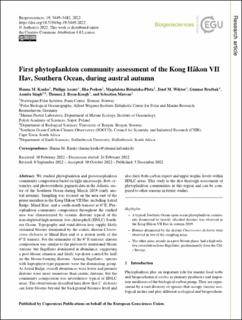| dc.contributor.author | Kauko, Hanna Maria | |
| dc.contributor.author | Assmy, Philipp | |
| dc.contributor.author | Peeken, Ilka | |
| dc.contributor.author | Rózańska-Pluta, Magdalena | |
| dc.contributor.author | Wiktor, Józef M | |
| dc.contributor.author | Bratbak, Gunnar | |
| dc.contributor.author | Singh, Asmita | |
| dc.contributor.author | Ryan-Keogh, Thomas J. | |
| dc.contributor.author | Moreau, Sebastien | |
| dc.date.accessioned | 2023-02-09T12:14:44Z | |
| dc.date.available | 2023-02-09T12:14:44Z | |
| dc.date.created | 2023-01-13T13:18:39Z | |
| dc.date.issued | 2022 | |
| dc.identifier.issn | 1726-4170 | |
| dc.identifier.uri | https://hdl.handle.net/11250/3049692 | |
| dc.description.abstract | We studied phytoplankton and protozooplankton community composition based on light microscopy, flow cytometry, and photosynthetic pigment data in the Atlantic sector of the Southern Ocean during March 2019 (early austral autumn). Sampling was focused on the area east of the prime meridian in the Kong Håkon VII Hav, including Astrid Ridge, Maud Rise, and a south–north transect at 6∘ E. Phytoplankton community composition throughout the studied area was characterized by oceanic diatoms typical of the iron-depleted high-nutrient, low-chlorophyll (HNLC) Southern Ocean. Topography and wind-driven iron supply likely sustained blooms dominated by the centric diatom Chaetoceros dichaeta at Maud Rise and at a station north of the 6∘ E transect. For the remainder of the 6∘ E transect, diatom composition was similar to the previously mentioned bloom stations, but flagellates dominated in abundance, suggesting a post-bloom situation and likely top-down control by krill on the bloom-forming diatoms. Among flagellates, species with haptophyte-type pigments were the dominating group. At Astrid Ridge, overall abundances were lower and pennate diatoms were more numerous than centric diatoms, but the community composition was nevertheless typical of HNLC areas. The observations described here show that C. dichaeta can form blooms beyond the background biomass level and also fuels both carbon export and upper trophic levels within HNLC areas. This study is the first thorough assessment of phytoplankton communities in this region and can be compared to other seasons in future studies. | en_US |
| dc.language.iso | eng | en_US |
| dc.publisher | Copernicus Publications | en_US |
| dc.rights | Navngivelse 4.0 Internasjonal | * |
| dc.rights.uri | http://creativecommons.org/licenses/by/4.0/deed.no | * |
| dc.title | First phytoplankton community assessment of the Kong Håkon VII Hav, Southern Ocean, during austral autumn | en_US |
| dc.type | Journal article | en_US |
| dc.type | Peer reviewed | en_US |
| dc.description.version | publishedVersion | en_US |
| dc.rights.holder | Copyright 2022 The Author(s) | en_US |
| cristin.ispublished | true | |
| cristin.fulltext | original | |
| cristin.qualitycode | 1 | |
| dc.identifier.doi | 10.5194/bg-19-5449-2022 | |
| dc.identifier.cristin | 2106587 | |
| dc.source.journal | Biogeosciences | en_US |
| dc.source.pagenumber | 5449-5482 | en_US |
| dc.identifier.citation | Biogeosciences. 2022, 19 (23), 5449-5482. | en_US |
| dc.source.volume | 19 | en_US |
| dc.source.issue | 23 | en_US |

